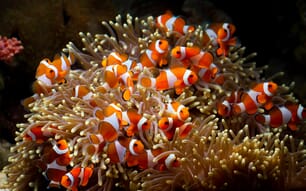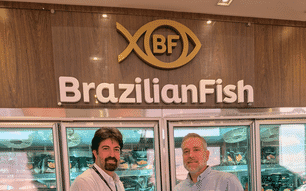Eel farming takes place worldwide and can be a lucrative business. It is estimated that the industry is worth over $1 billion, with eel farms producing around 60 percent of the eel meat consumed.
Eels are a carnivorous, long-living species group that spend most of their life in fresh water, but return to the sea to breed.
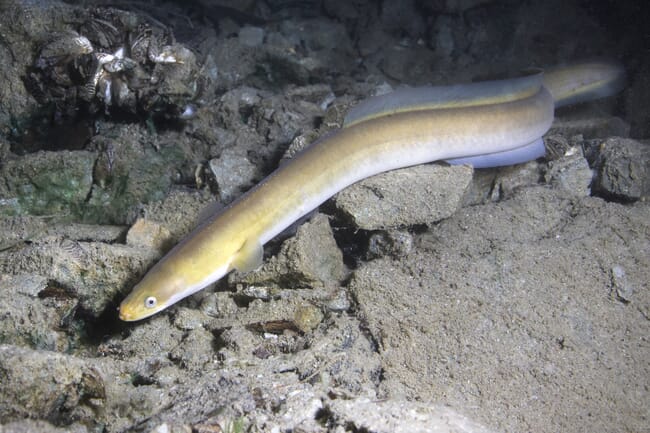
On average, the young eels live in the fresh water of rivers and streams for up to 12 years for males and up to 18 years for the females. When they reach sexual maturity their skin pigment becomes silvery, they put on weight and they migrate miles out into the seas to find the spawning grounds to breed. The eel only breeds once during its lifetime.
The fertilised eggs are carried by the ocean current as they change into larvae, and then after around 18 months they develop into "glass eels" - juveniles that have an under-developed, transparent appearance.
When the glass eels reach 2-3 years old, their pigmentation becomes darker and they resemble adult eels, only much smaller at around 8-20 cm in length. These young eels are called elvers, which migrate back into fresh water to feed and grow.
Farming eels
Eel farms are widespread, with a number of significant producers in Europe, Scandinavia, China, Taiwan, Australia and Morocco. However, the largest single producer is Japan.
The farms begin by sourcing wild glass eels which are typically captured in river mouths in nets. It is important for these to be quarantined for several weeks and carefully inspected for any signs of parasites or disease. Eels are an ideal species to be farmed because they are very tolerant and can be kept in high densities.
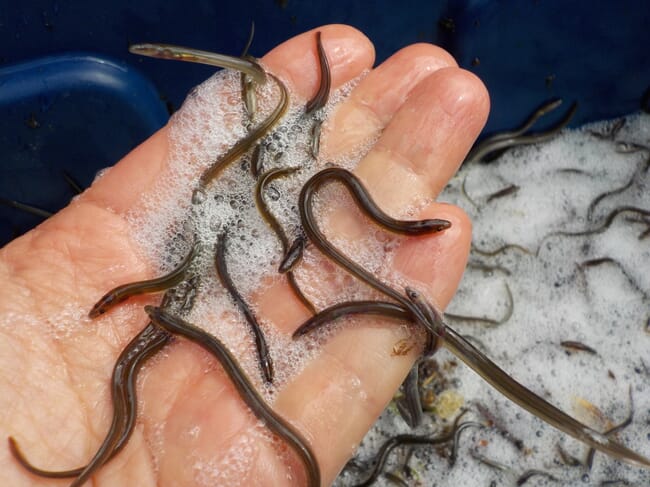
After quarantine, the eels can then be grown-on in ponds or in specialised tanks that recirculate the water. The temperature of the water must be kept between 23°C and 28°C to ensure optimal growth and health of the fish.
This means that in hotter climates, growing eels in pond set-ups may be more suitable as the water will naturally be at a warmer temperature. In cooler climates, the most common way to farm is by using the tank system, although there are methods of heating the water in the ponds also, such as using solar or geothermal heating methods. Due to ponds generally being larger than tanks, they can produce a higher yield of eels and therefore more profit for the farm.
For the most intensively farmed eels, tanks that incorporate recirculation systems are mostly used. The tanks are usually made from concrete or fibre glass, and the setup also features filtration systems to remove debris such as faeces and waste food particles from the water. Using a recirculation system means that the environment that the eels are in can be completely controlled, allowing the farmers to provide the best conditions for growth.
Another way of cultivating eels is by a method called valliculture. Rather than using pond or tanks, farmers use the natural areas of the coast to grow the eels. This might be from making use of natural lagoons and by setting up a weir to keep the eels from escaping into the open waters, keeping them contained so that the can be harvested once they reach the desired size. This method of farming eels is popular in the Mediterranean region.
When growing eels on in ponds or tanks, regular grading must take place to reduce cannibalism and competition for food. Every six weeks, the eels must be graded and separated into different size categories. If all different sizes are kept together, the larger eels will eat the smaller ones.
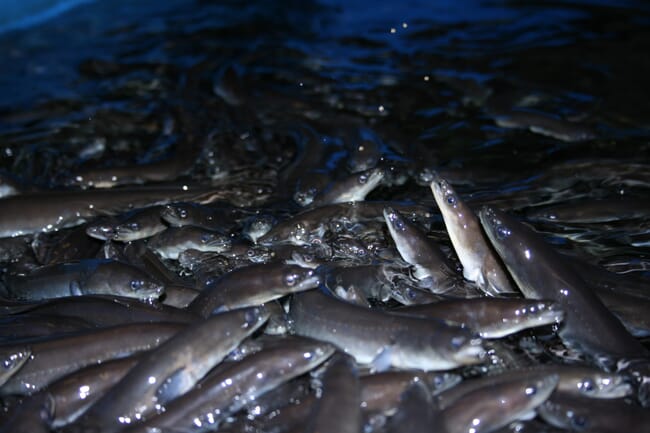
There are many designs of fish grading equipment commercially available, yet they all work using the same principle. The consist of an entrance that the fish swim into, and then there are different sized gaps that allow the smaller fish to return to the ponds or tanks, while retaining the larger fish that can be moved to other tanks or to be prepared for harvesting.
Providing eels with the right food is important to their health and growth. Being meat eaters, protein is an essential requirement. Commercial foods are widely available, consisting of a protein paste for young eels and pellets for older eels. These foods consist of high quality fish proteins, oils and nutrients to produce optimal growth.
The protein-based food, and also the high volume of eels that are kept together, mean that the water in the ponds or tanks becomes dirty quickly. Although very tolerant of many conditions, when the water becomes too dirty it can cause stress for the eels. This is another reason why access to lots of clean water is essential.
Harvesting the eels is done by grading the sizes to make sure each eel is large enough to reach market value. It is important to keep stress to a minimum while grading, so as not to affect the health of the eel. The large eels that are ready for harvesting are put into tanks with clean water to flush out any possible impurities in their systems that could affect the taste. Their food is also stopped 1-2 days prior to harvest.
Eels that are to be freshly consumed are chilled and put into bags that are filled with oxygen. There should also be enough water in the bag to keep their skin moist. They are then ready for transportation to market. Eels that are to be smoked are usually transported alive to the processors.
Common farmed species of eel
- Longfin eel (Anguilla reinhardtii) and the shortfin eel (Anguilla australis) – found in brackish and fresh waters of Australia and New Zealand, and are the most commonly farmed species in the countries.
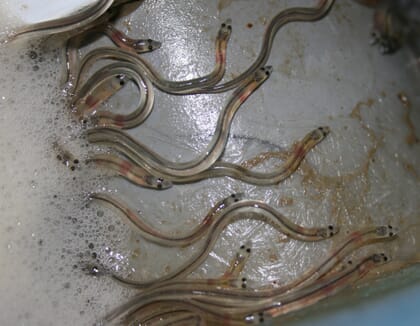
- European eel (Anguilla anguilla) - found in fresh and brackish water in the UK, Ireland, Mediterranean, Northern Africa the Baltic Sea, and Iceland up to mid-Norway.
- American eel (Anguilla rostrata) – found in brackish and fresh water on the eastern side of the United States, the south- east of Canada and the Gulf of Mexico.
- Japanese eel (Anguilla japonica) – most common in the fresh and brackish waters of Japan, Korea China and Taiwan. This eel is particularly suited to pond cultivation in these countries as they are naturally acclimatised to higher water temperatures.
Common ailments and treatment
The young glass eels most commonly come from the wild, so they are more prone to carry parasites or diseases. It is important to quarantine the glass eels before introducing them to tanks with other fish. The change from salt to fresh water also helps to eliminate many parasites naturally. However, below are some parasites and diseases that need further attention.
Fungal infections
Symptoms include swellings on the body, gills or fins. There can also be white or brown fibrous patches on the skin, which can cause the eel to die when on the gill area. Treatments include salt water solutions or the removal of the infected eel so the fungus does not spread to other eels.
Parasites
Symptoms of a parasitic infection include an increase in mucus, frayed fins, lethargy, respiratory distress and white patches on skin. The eel may display changes in behaviour such as attempting to rub off parasites on the surface of the enclosure. Treatments for parasites include formaldehyde or salt solutions.
Red fin
This is a bacterial disease that affects the fins. The symptoms are a rotting of the tail and fin areas. Treatment is with a salt solution.
Red eel pest
This bacterial disease causes symptoms of swelling, red spots and ulcerated lesions on skin. Treatment is with antibiotics.
Red head
A viral disease that shows as haemorrhages that spread from the head to other parts of the eel’s body. Treatment is through vaccination of young fingerlings, salt water solutions and also by decreasing the temperature of the water.
During times of stress, such as when being handled, graded or if the water becomes poor quality, eels can also become more susceptible to infections. Care must be taken to keep the stress levels to a minimum at all times in order to produce healthy fish. Prevention is always better than cure, so regular maintenance and cleaning of equipment are recommended, and also routine inspections of eel stock.
The future of eel farming
Eel farming has long been a worldwide industry. However, there is now concern over its sustainability, due the decreasing number of elvers found in the wild. This is particularly significant for the European eel, whose numbers have dramatically declined in recent years. The reason for the decline is not yet known, although there are a few contributing factors.
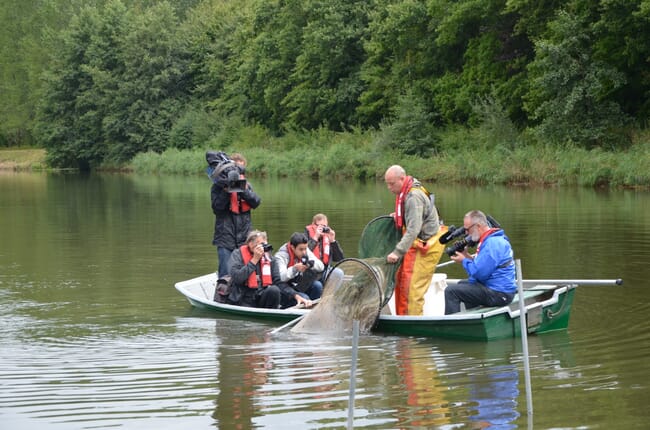
One reason could be from the over fishing of glass eels, meaning fewer eels reach maturity in rivers and streams, leading to the decline in the overall wild population.
Another factor could be the increasing amount of flood defences, which prevent the elvers from being able to progress up the rivers and streams as they could do with ease before. Again this would affect the numbers of the wild population. This means that in the future there may be regulations in place as to the quantities of elvers that can be caught for the purpose of restocking eel farms.
There are programmes now in place in parts of the UK whereby 60 percent of all caught elvers can be sold to farms, and the other 40 percent are taken and released further upstream, in an effort to boost the population numbers. Because of the complex lifecycle of the eel, breeding stock in captivity is something that is not possible as yet. Eels spend months travelling to the spawning grounds to breed in the sea.
So far, artificial ways of breeding eels for commercial farming purposes have not been successful. Until methods are discovered as to how to breed hatchings from the eel spawn, the industry will not be truly sustainable and will always depend on the supply of wild glass eels for its success.



